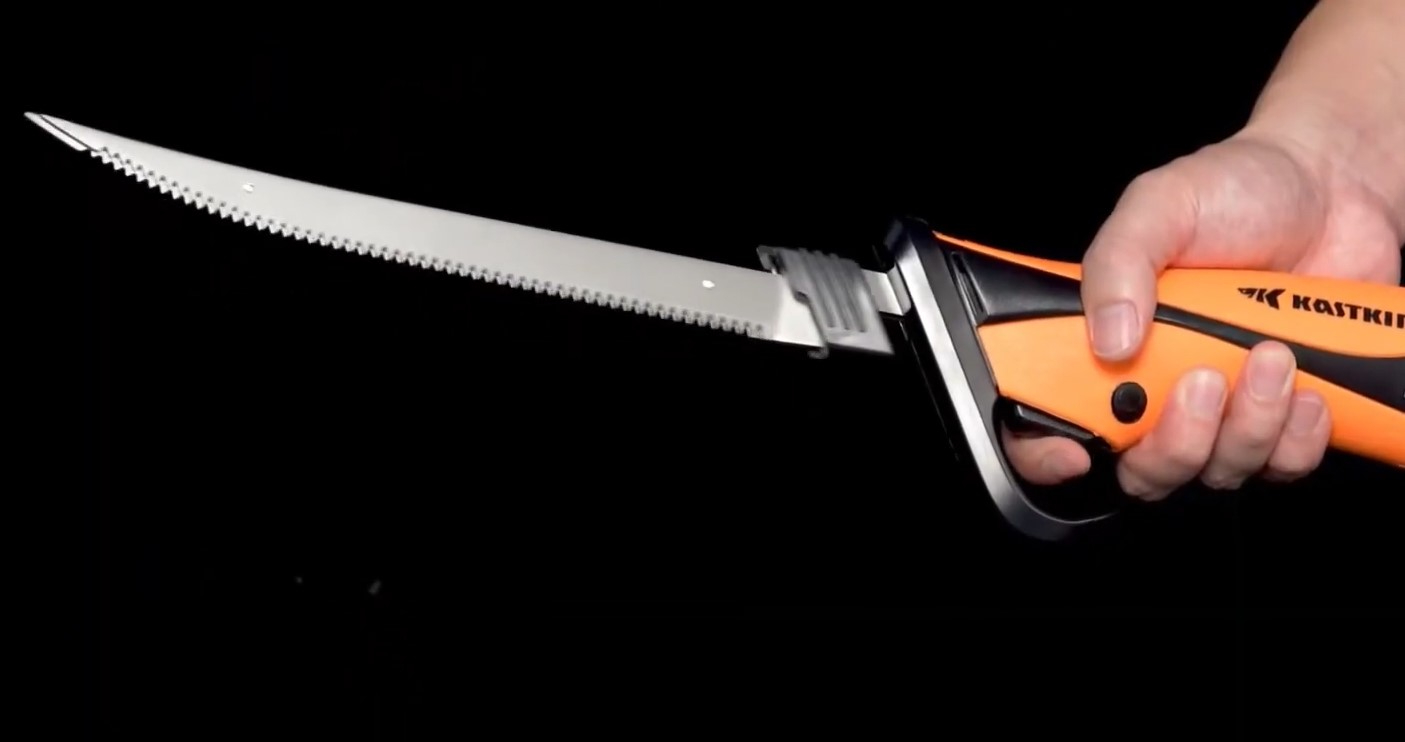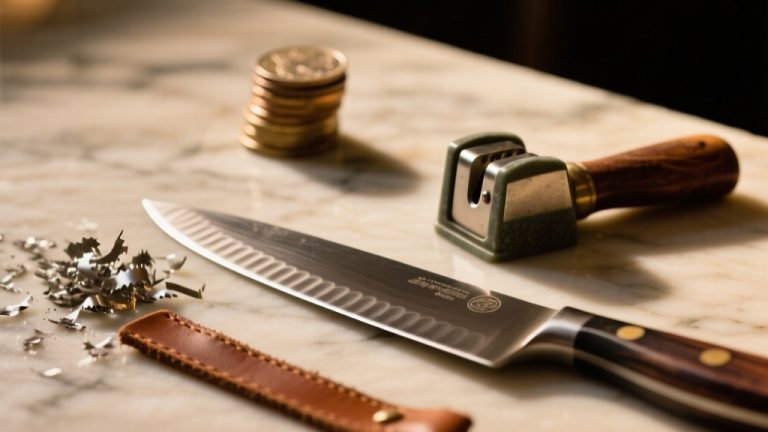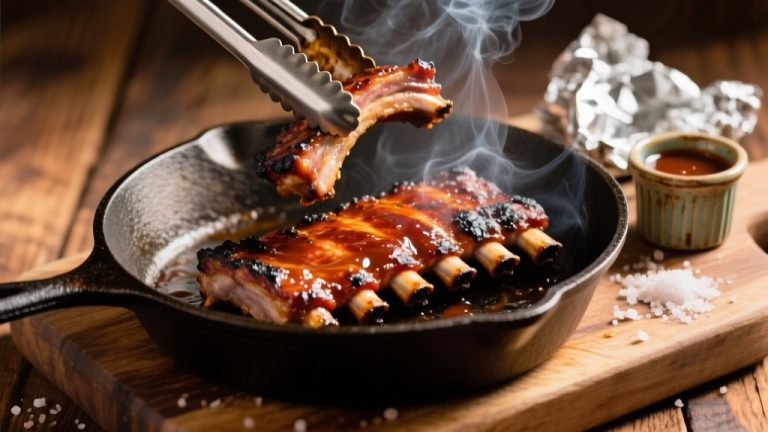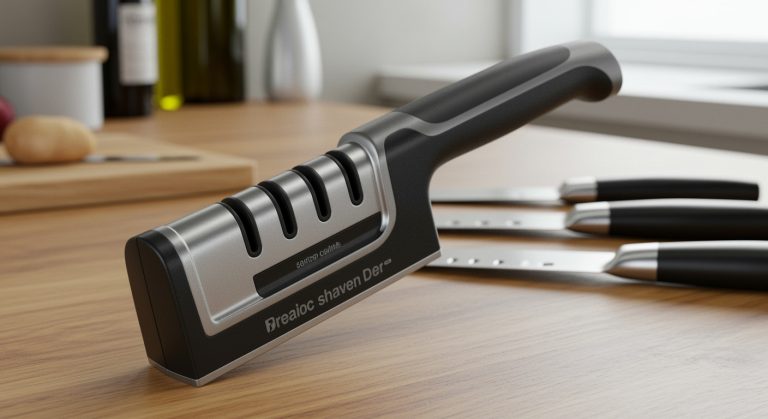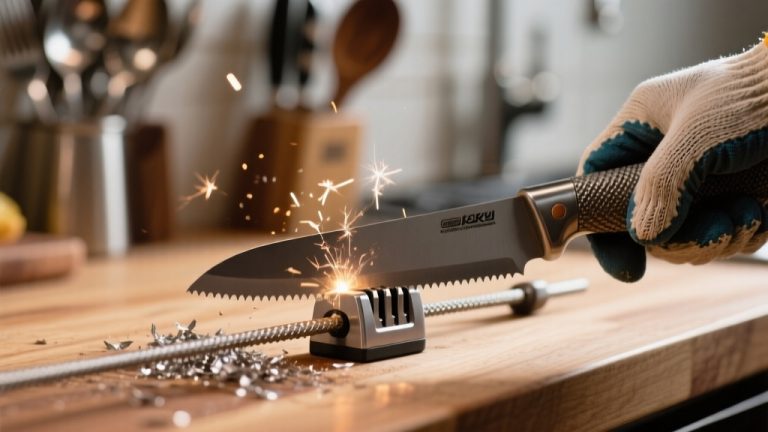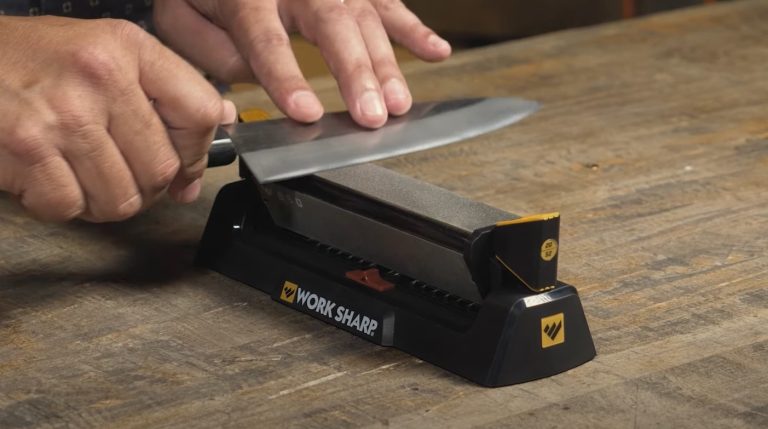How to Sharpen Electric Fillet Knife Blades: Tips and Techniques
To sharpen electric fillet knife blades effectively, start by cleaning the blade to remove debris. Use a quality electric sharpener that’s compatible with your knife’s design.
Progress through coarse and fine grit slots, maintaining consistent pressure for even sharpening. Make sure you follow the manufacturer’s instructions to prevent damage to the blade.
Regular maintenance is crucial for precision in your cutting tasks. Discover more techniques and tips to enhance your sharpening skills efficiently.
Key Takeaways
- Clean the electric fillet knife blade thoroughly before sharpening to ensure hygiene and prevent debris from affecting the process.
- Use a high-quality electric sharpener compatible with fillet knife blades to maintain their integrity during sharpening.
- Follow a step-by-step process: start with coarse grit to reshape the edge, then progress to finer grits for a polished finish.
- Regularly check sharpness after sharpening to ensure optimal performance and to avoid cutting difficulties in future use.
- Store your sharpened knife safely to prevent dulling and damage, maintaining its sharpness for longer periods.
Importance of Sharpening Electric Fillet Knife Blades
When it comes to electric fillet knives, sharpening the blades is vital for peak performance. A sharp blade guarantees efficiency and precision in your cuts, particularly essential when filleting delicate meats or fish.
Dull blades demand more force, increasing the risk of accidents and injuries. Regular sharpening not only extends the lifespan of the blade but also enhances overall performance, making your tasks much easier.
You’ll notice an improved cutting experience, which reduces fatigue and stress while preparing food. Additionally, precise cuts contribute to better food presentation, whether for personal meals or professional settings.
Proper sharpening process is crucial for achieving the desired sharpness and maintaining the blade’s effectiveness. Regular honing can help maintain sharpness between full sharpenings, ensuring you achieve optimal performance from your electric fillet knife.
Understanding Serrated Blade Design
Serrated blade design plays an essential role in the functionality of electric fillet knives, offering unique advantages that enhance cutting performance.
The serrated edge, featuring tooth-like protrusions, excels at slicing through tough materials with minimal downward force. Typically crafted from high-carbon stainless steel, these blades guarantee durability and corrosion resistance.
Culinary serrated knives are specifically designed to handle various food textures, showcasing how serrated designs cater to specialized cutting needs.
The cutting action relies on multiple pressure points, effectively distributing force as you cut. With a pointed tip for precise slices and a belly designed to grip and tear, serrated blades are versatile for both robust surfaces and delicate interiors.
Reduced friction between serrations allows for smoother cuts, while the increased surface area enhances overall efficiency, making these blades a go-to choice for your filleting needs.
Manual Sharpening Techniques for Serrated Blades
To effectively sharpen serrated blades, you’ll need specific tools like diamond or ceramic rods that fit the serration size. These tools include tapered diamond or ceramic sharpening rods, which are preferred for achieving the best results.
Start with a clear step-by-step process to match the grind angle and apply consistent pressure for even sharpening. This approach not only refines the edge but also guarantees the longevity of your electric fillet knife.
Required Tools Overview
Effective manual sharpening of serrated blades requires a selection of specific tools tailored for the task.
Begin with sharpening rods, which offer better control during the process. Consider using diamond abrasives for faster sharpening, as they maintain effectiveness without compromising blade integrity.
Electric sharpeners are designed for both professional and home use, making them a versatile choice for various sharpening needs. It’s important to note that blade length can significantly affect the sharpening technique used.
Precision angle guides are essential to guarantee you maintain a consistent angle, which is critical for effective sharpening. Additionally, stropping disks can polish the blade edge for a sharper finish.
While electric sharpeners provide convenience, they may be too harsh on serrated blades, so choose wisely.
Step-by-Step Process
When sharpening serrated blades, following a structured approach guarantees ideal results. Start by disconnecting power and inspecting the blade for damage. Clean it thoroughly, then choose a sharpening rod to match serrations at a 15-20 degree angle.
Regular honing is recommended between sharpening sessions for stainless steel blades, as it helps maintain consistent sharpness over time.
| Step | Action | Detail |
|---|---|---|
| Preparation | Disconnect and inspect | Verify safety and condition |
| Sharpening | Use sharpening rod | Focus on each serration |
| Finishing | Clean and dry blade | Prevent rust and maintain edge |
Apply consistent pressure while sharpening each serration, and switch to finer grit as needed. Regularly check for sharpness to avoid over-sharpening, repeating the process until desired sharpness is achieved.
Using Electric Sharpeners for Efficient Results
When you choose an electric sharpener, prioritize quality and make certain it’s compatible with your knife’s blade type. Regular maintenance is essential for sharp knives to ensure precise cuts and efficient preparation.
Follow a step-by-step process starting with a clean blade, using coarse grit to remove dullness, and finishing with finer grits for a polished edge. This method guarantees efficient sharpening and maintains the integrity of your electric fillet knife blades.
Choosing the Right Sharpener
How can you confirm that your electric fillet knife blades stay sharp and effective? The key lies in choosing the right electric sharpener. Here are four vital considerations:
- Quality Considerations: Always opt for high-quality sharpeners to avoid damaging your blades. Regular visual inspections will help you maintain optimal knife performance and safety.
- Compatibility: Verify the sharpener suits your blade type whether serrated or straight-edged.
- Reviews and Feedback: Check online reviews to gauge the sharpener’s effectiveness and reliability.
- Brand Reputation: Stick to reputable brands known for performance and durability in maintaining the cutting power of your knives. Investing in a sharpener that adheres to ISO Standards Compliance ensures consistency and validity in sharpening evaluations.
Step-by-Step Sharpening Process
Choosing the right sharpener sets the stage for an effective sharpening process. Begin with a serrated blade-specific electric sharpener. Follow these steps for ideal results:
| Step | Action | Purpose |
|---|---|---|
| Coarse Sharpening | Use the coarsest stone first | Remove nicks and dullness |
| Fine Sharpening | Switch to finer stones | Refine edge sharpness |
| Polishing Stage | Final polish with finest stone | Achieve ideal sharpness |
Ensure proper blade alignment and maintain consistent pressure throughout. Regularly sharpening your knife can significantly improve the food prep experience. Repeat each stage multiple times and test sharpness afterward. Clean the blade post-sharpening and store it safely.
Tips for Achieving Optimal Sharpness
To achieve ideal sharpness for your electric fillet knife blades, it’s vital to focus on the tools and techniques that enhance the sharpening process.
Here are four essential tips to keep in mind:
- Use Appropriate Tools: Choose sharpening stones or rods that offer control, and consider diamond dust pads for tougher metals. Additionally, proper selection of sharpening stones ensures optimal results based on the blade’s material. Using tools that match the knife steel composition can significantly improve the sharpening outcome.
- Maintain Consistent Angles: Keep a 15-20 degree angle while sharpening to guarantee evenness and precision. This angle range is effective for both electric fillet knives and standard kitchen knives.
- Look for Burr Formation: A rough burr indicates successful sharpening; aim for this during your process. Ensuring the burr is present shows that you’ve achieved sufficient sharpness.
- Finish with Fine Grit: Polishing the blade edge with fine grit further refines sharpness and improves performance. This step is crucial for achieving a keen edge that enhances cutting efficiency.
Comparing Manual and Electric Sharpening Methods
Achieving ideal sharpness for your electric fillet knife blades involves understanding the differences between manual and electric sharpening methods. Each method has its pros and cons, impacting performance and longevity.
| Feature | Manual Sharpening | Electric Sharpening |
|---|---|---|
| Control | High precision with stones | Limited to machine settings |
| Speed | Slower, requires practice | Fast, user-friendly |
| Blade Longevity | Maintains edge integrity | Can cause wear over time |
| Skill Requirement | High, needs experience | Low, easy for beginners |
Choosing the right method depends on your knife type, sharpening frequency, and desired sharpness. Manual sharpening is ideal for maintaining blade longevity, while electric methods cater to convenience and speed.
Frequently Asked Questions
How Do I Know When My Knife Needs Sharpening?
Your knife’s edge is like a finely tuned instrument; when it starts to struggle, it’s time for attention.
Look for signs: if it tears through materials instead of slicing, or if cutting requires more pressure, you’ve got a dull blade.
Perform tests like running your thumb along the edge or slicing through paper. If it catches or tears, that’s a clear signal it needs sharpening.
Regular maintenance guarantees peak performance and longevity.
Can I Sharpen My Fillet Knife at Home?
Yes, you can sharpen your fillet knife at home. Use a sharpening stone or an electric sharpener, ensuring you maintain the correct angle of 15 to 20 degrees.
Regularly test the sharpness with a thumb test. For serrated fillet knives, focus on sharpening between the serrations.
Make sure to clean the blade thoroughly after sharpening to remove any metal dust, and store it safely to protect the edge.
Regular maintenance keeps your knife performing at its best.
What Happens if I Over-Sharpen the Blade?
If you over-sharpen your blade, you risk reducing its lifespan by removing too much metal. This can lead to uneven wear and an unstable edge that won’t hold sharpness well.
You might also experience increased drag while cutting, making tasks less efficient.
Furthermore, over-thinned blades can break under stress, posing safety concerns.
Regular inspection and proper sharpening techniques can prevent these issues, ensuring your blade maintains peak performance.
Are There Specific Brands Recommended for Sharpeners?
When choosing a sharpener, consider brands like Smith’s Consumer Products for a variety of options, or Chef’s Choice for precise electric sharpeners.
Work Sharp offers both electric and manual tools with adjustable settings, while Presto is user-friendly and suitable for home use.
Messermeister provides high-quality tools aimed at professionals.
Always verify the sharpener matches your blade type and read reviews to gauge effectiveness before making a purchase.
How Should I Store My Electric Fillet Knife?
To store your electric fillet knife, keep it in a dry environment to prevent rust.
Avoid extreme temperatures that could damage the blade.
Use the original case or a protective cover to safeguard the blade and prevent accidents.
Make certain the knife’s kept out of reach of children and pets.
Regularly inspect it for any signs of wear.
This way, you’ll maintain the knife’s condition and make certain safety during storage.
Perfect Cuts, Perfect Meals: Keep Your Fillet Knife in Tune
Just like a well-tuned guitar produces harmonious melodies, a sharpened electric fillet knife slices through fish with precision and ease.
By taking the time to sharpen your blades whether manually or with an electric sharpener you guarantee your culinary creations sing with flavor. Remember, a dull blade is like a musician out of tune; it hinders the performance.
So, keep your knife sharp, and let it dance through your catch, transforming your fishing efforts into a symphony of delicious meals.

